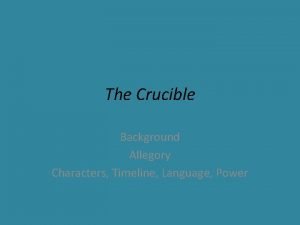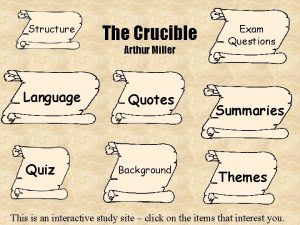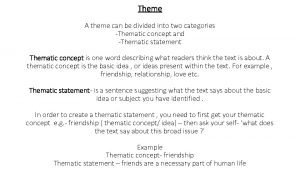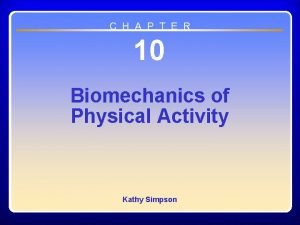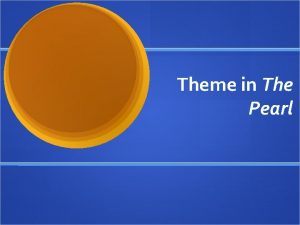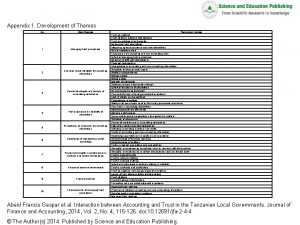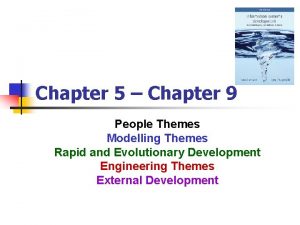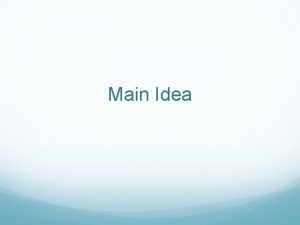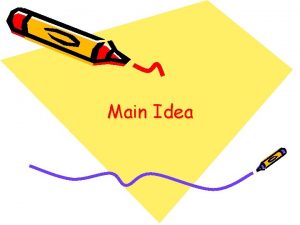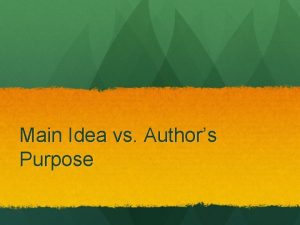Overview of 3 main Chapter 19 themes A



















- Slides: 19

Overview of 3 main Chapter 19 themes: (A) bulk flow in vessels, (B) filtration, (C) diffusion 4 th theme (less related to this figure): blood pressure and its regulation https: //oli. cmu. edu/jcourse/workbook/activity/page? context=b 880 f 0 e 680020 ca 600 d 4 ead 572 bb 0410 1

Ch. 19: Test Question Templates • Q 1. Given an anatomical change/different relating to a variable in the Fick or Poiseuille equations, explain how this change/difference changes the diffusive flow or bulk flow. • Example. Which is greater, diffusion of O 2 out of the brachial artery into surrounding muscles, or diffusion of O 2 out of the capillaries that serve these muscles? Explain in terms of the Fick equation. • Q 2. Given a change in a variable that affects HPc, OPc, HPif, or OPif, say whether this change increases the risk of edema. • Example. Heart rate increases. (Everything else stays the same. ) • Q 3. Given a figure such as Marieb & Hoehn Figure 19. 15, answer a question about the control of blood flow. • Example. Based on Figure 19. 15, do you think cutaneous arterioles have alpha-adrenergic receptors or beta-adrenergic receptors or neither? Explain. 2

Flow Down Gradients: Diffusion and Bulk Flow rate? Gradient that drives the flow? Poiseuille’s law Fick’s law Figure: J. Michael et al. (2017), The Core Concepts of Physiology 3

Bulk flow in blood vessels: Poiseuille’s Law http: //www. physics. usyd. edu. au/teaching/Ag/Transfer/TPpoiseuille. html 4

How the various factors in the Poiseuille equation affect flow Impact on flow if this factor ↑ Factor Example of this factor ↑ P 1 (pressure) ↑ cardiac output η (viscosity) ↑ hematocrit r (radius) Vasodilation L (vessel length) Surgical change to vessel π (pi) God destroys the universe and starts over? Never mind… 5

Filtration through capillary walls: hydrostatic & osmotic pressures Q 1. What is hydrostatic pressure (HP)? Q 2. What is osmotic pressure (OP)? Q 3. Will the capillaries have both HP (HPc) and OP (OPc)? Q 4. Will the interstitial fluid have both HP (HPif) and OP (OPif)? https: //oli. cmu. edu/jcourse/workbook/activity/page? context=b 880 f 0 e 680020 ca 600 d 4 ead 572 bb 0410 6

Marieb & Hoehn (2019), Focus Figure 19. 1 7

Marieb & Hoehn (2019), Focus Figure 19. 1 8

Q 1. Overall, from the beginning of the capillary to the end, is there a net filtration of fluid into the interstitial fluid, or a net reabsorption into the capillary, or a net change of 0? Q 2. If/when there is net movement of fluid, where does that fluid go? Q 3. What is edema? Now consider possible causes of edema, based on the various pressures involved. Q 4. Would a liver disease that impairs production of plasma proteins increase the risk of edema? Why or why not? 9

Diffusion across cell membranes: Fick’s Law of Diffusion C 1 C 2 A= e c a f r u s area k = a “constant” (depends on solute, solvent, etc. ) d = thickness of diffusion barrier

Q 1. Which way will these molecules diffuse at the “tissues” (e. g. , skeletal muscles)? Will each use simple diffusion, facilitated diffusion, or active transport? Diffusion at skeletal muscles a. O 2 b. CO 2 c. glucose Q 2. Does much diffusion occur through arterial walls? Why or why not? Martini et al. (2015), Figure 23 -18 11

Blood pressure (BP) and its regulation Q 1. Fill in the labels: • Systolic pressure • Diastolic pressure • Mean pressure Q 2. Where are the main baroreceptors for monitoring BP? Q 3. Which pressure(s) must be regulated homeostatically? • Arterial? • Capillary? • Venous? Marieb & Hoehn (2019), Figure 19. 7 12

How is (arterial) BP regulated? Basically, you can change 3 things: Q 1. Which of these can be adjusted QUICKLY (within seconds)? Q 2. Which of these must be adjusted SLOWLY (over hours/days)? Clip art from livestrong. com and clipartbarn. com 13

Maintaining BP during exercise Muscle vessels are dilated to increase O 2 delivery and CO 2 removal. Q 1. Why do we need to vasoconstrict other vessels? Q 2. How does the sympathetic nervous system coordinate these vasodilations and vasoconstrictions? (Hint: think about adrenergic receptor subtypes!) Marieb & Hoehn (2019), Figure 19. 15 14

This diagram illustrates the regulation of blood pressure. As usual, the teetertotter represents homeostatic control (BP shouldn’t be too high OR too low). Q 1. What is the little yellow thing? Q 2. Which parts of the brain serve as the control center? Q 3. What are the effects on the heart and arterioles in each case? Q 4. What specific branch of the nervous system makes these adjustments? Marieb & Hoehn (2019), Figure 19. 11 15

BP regulation: SLOWER adjustment: • Antidiuretic hormone (ADH) from _______ • Erythropoietin (epo) from _______ • Aldosterone from ________ • Angiotensinogen from ________ Q 1. Are these nervous system or endocrine system adjustments? Q 2. How does each affect blood volume? 16

Q 3. Why is hemorrhage a challenge to BP regulation? Q 4. How will the body respond (short-term)? Q 5. How will the medical staff respond (short-term)? Q 6. Why might fainting help? wisegeekhealth. com/what-is-fainting. htm 17

Ch. 19: Additional resources • Pearson Mastering has a good Interactive Physiology segment on this. • IP 2: Factors Affecting Blood Pressure • Other suggestions? Let me know! 18

Answer key for Suggested Lecture Outline file • You should already have access to answers to some of the questions (Check Your Understanding, online Practice Quiz, online Practice Test) • Answers to pre-lecture questions and end-of-chapter Review Questions will be in the Presenter Notes that accompany this slide. 19
 Motifs in the crucible
Motifs in the crucible The crucible act 3 timeline
The crucible act 3 timeline The crucible exam questions
The crucible exam questions Reverand hale quotes
Reverand hale quotes Hamlet themes
Hamlet themes Frankenstein plot
Frankenstein plot Hiroko tanaka burnt shadows
Hiroko tanaka burnt shadows The text is divided into 2 main themes:
The text is divided into 2 main themes: Two main themes of biomechanics
Two main themes of biomechanics The pearl themes
The pearl themes Romeo and juliet key themes
Romeo and juliet key themes Conceit romeo and juliet
Conceit romeo and juliet Romeo and juliet theme analysis
Romeo and juliet theme analysis Ways of expressing future time
Ways of expressing future time Main ideas examples
Main ideas examples Void main int main
Void main int main Emt chapter 24 trauma overview
Emt chapter 24 trauma overview Emt chapter 14 medical overview
Emt chapter 14 medical overview Chapter 9 lesson 2 photosynthesis an overview
Chapter 9 lesson 2 photosynthesis an overview Chapter 12 selling overview
Chapter 12 selling overview

